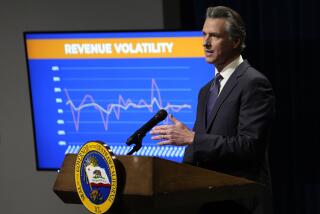State Revenue Windfall: It’s Far From a Cure-All
- Share via
From the euphoria emanating from Sacramento, it would seem the state Capitol is awash in new money. Indeed, a $2.2-billion revenue windfall is nothing to sniff at, not to mention an additional $1 billion saved from elsewhere in the budget. These are the benefits of a revitalized economy.
It would be a mistake, however, to think that this bonanza, as welcome as it might be, will solve all of California’s problems or even its most pressing ones.
One thing it does for now is buy considerable political breathing room for Republican Gov. Pete Wilson and Democratic legislative leaders to work out a state budget compromise before the start of the new fiscal year July 1.
Under a Wilson proposal, the revenue windfall would allow California to take a big step toward improving public education through additional class-size reduction. The governor also has enhanced prospects for an agreement on welfare reform by proposing that $278 million be used to finance child care for welfare recipients being moved into jobs.
Wilson should get credit for coming up with constructive proposals, although he had little choice in terms of the $2.2 billion in newly anticipated revenue. State law requires that virtually all of it be spent on the schools. And cutting class size is an obvious, and popular, priority.
Wilson’s popularity took a beating during the recession, so there’s nothing wrong with his taking some political credit now that good times have returned. After all, good public policy makes for good politics. But it’s also good to view the windfall in terms of the state’s total financial situation. For starters, it is the result of a small shift in economic forecasts, a 2.6% increase in expected revenues through June of 1998. Is this a one-time quirk? Or will revenues continue to expand at that rate? No one knows now.
The windfall also must be balanced against total state needs. Ever since the property tax revolt spawned Proposition 13 back in 1978, most programs have been squeezed, cut and trimmed--falling behind inflation and population growth.
Since 1991, state population has increased by 9% but general fund spending has gone up only one-half of 1%. Highway construction and maintenance have declined by 50% when measured against personal income over the past 20 years. General government spending is down by 29% in constant dollars. State workers haven’t had a pay raise in three years.
California must consider how much in the hole the state has been and how much catching up there is to do. Even with a $2-billion transfusion this year, state support for public education per pupil still will be below the national average.
There is a growing backlog of building projects throughout the state, but California has no formal capital outlay planning process. Transportation planning lags behind needs. And as population once again begins to soar and begins crowding out prime Central Valley farmland, there is no state land-use plan.
Enjoy this windfall now. But soon, California must begin some serious long-term planning and investment for the future. Good public schools are essential. But so too is higher education. Add to that highways, bridges and the rest of a transportation system for the 21st century; stewardship of the state’s resources; protection of the environment, including the coast, and the re-creation of a public sense that Californians working together can make life better for themselves and others. These are, after all, the things that made it the Golden State in the first place.
More to Read
Get the L.A. Times Politics newsletter
Deeply reported insights into legislation, politics and policy from Sacramento, Washington and beyond. In your inbox twice per week.
You may occasionally receive promotional content from the Los Angeles Times.










